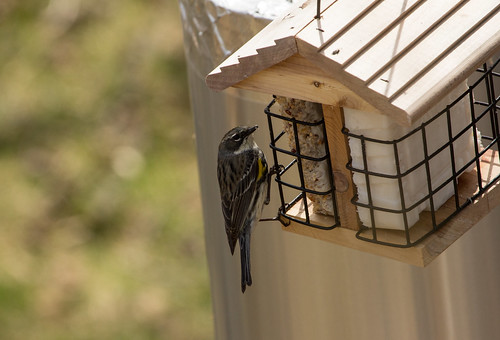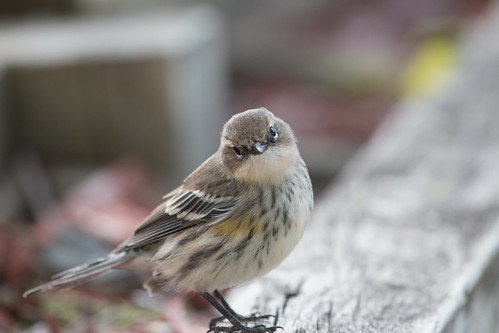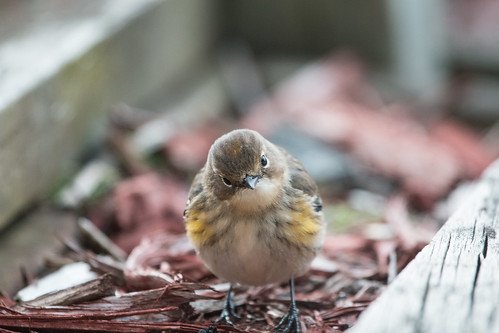 |
| This Yellow-rumped Warbler in Port Wing, Wisconsin, wasn't visiting a feeder in October 2014--I was smacking cluster flies in the window and tossing them out for her. |
On January 16, the day I flew to San Diego for a week of
birding and relatively balmy temperatures in Southern California, I got an
email from Maxene Linehan of Hovland, just north of Grand Marais. She wrote:
For the past weeks we have had
consistent daily sightings of a yellow-rumped
warbler at our suet feeders, so I have been offering a variety of suet and
was able to obtain dried mealworms, putting them in our platform feeder.
With our LOOOONG autumn lasting into the end of November I wondered if warblers would have a second late brood under those conditions, and maybe this one got left behind.
She has been extra feisty, guarding "her" platform feeder from the chickadees, and trying to engage them in aerial combat, much to their chagrin. Each day she is still with us, as it gets colder, it amazes me and I wonder where she sleeps in the cold. I do have some small-bird houses out that I altered for winter (hole at bottom, upper perch inside, Styrofoam added atop roof and sides) but haven't been able to track her. She is very shy and flies to the woods when we come out.
So, if you can believe this, any info you can give, food wise or for shelter would be MUCH appreciated. She seems to favor the suet cakes home-made by the proprietor of our local store and I shred them into smaller insect size pieces with a spoon instead of putting the cake out in solid form that gets frozen hard.
warbler at our suet feeders, so I have been offering a variety of suet and
was able to obtain dried mealworms, putting them in our platform feeder.
With our LOOOONG autumn lasting into the end of November I wondered if warblers would have a second late brood under those conditions, and maybe this one got left behind.
She has been extra feisty, guarding "her" platform feeder from the chickadees, and trying to engage them in aerial combat, much to their chagrin. Each day she is still with us, as it gets colder, it amazes me and I wonder where she sleeps in the cold. I do have some small-bird houses out that I altered for winter (hole at bottom, upper perch inside, Styrofoam added atop roof and sides) but haven't been able to track her. She is very shy and flies to the woods when we come out.
So, if you can believe this, any info you can give, food wise or for shelter would be MUCH appreciated. She seems to favor the suet cakes home-made by the proprietor of our local store and I shred them into smaller insect size pieces with a spoon instead of putting the cake out in solid form that gets frozen hard.
I was out of range to check my email much on my trip, so I
didn’t have time to respond before she wrote back telling me she'd found information that indicated Yellow-rumped Warblers are pretty hardy:
I learned that they are found as far north as Labrador in winter (granted, we may have harsher winters, don't know for sure), and that they turn to berries and such when insects aren't available. The source said they will accept sunflower seeds (we put out hearts in mid winter) and even peanut butter. So I put out raisins and dried blueberries with the seeds, suet and dried mealworms. Quite the buffet... the chickadees like it too.
She soon wrote back adding:
I think she must have hatched late
in the season. As she eats the shredded suet cake I put in "her" tray feeder, she flutters her wings like a
begging nestling! (Maybe, too, that keeps her warm when perched?)
Maxene ended with, “Each day I see her is closer to spring.”
It's possible but highly unlikely that the warbler represented a late hatching. There's no way that a pair of adults could have brought off a nest in August or September—there's barely any anecdotal evidence that this species ever nests twice in the same season. I'm intrigued with the behaviors she described. The bird was assertive enough to take over one feeder from the chickadees, and so my guess is that it was opening its wings aggressively, possibly towards those chickadees or other birds. I've seen chickadees during their first fall holding their wings out to claim dominance over young flock mates.
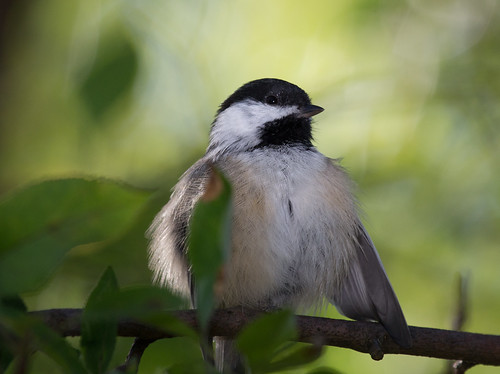 |
| This young chickadee, in September 2014, was fluffed out and spreading its wings to assert itself over the chickadees in its new fall flock. (The adults just seemed to roll their eyes.) |
This behavior of Maxene's warbler would have been a fascinating behavior to observe, photograph, and even make a video of. If I hadn't been in California, it would have been worth the drive to Hovland just for that.
I'm not surprised it found her feeder. In the first 20 years we lived here, we had none ever at the feeder until one showed up on a cold, drizzly day in April 2001.
I went more than a decade without seeing another at the feeders, though they have always been common migrants in my trees. But they do seem to pay attention to chickadees and other feeder birds, and in Spring 2013, one showed up at one of my feeders again.
In 2014, fairly large flocks turned up in both spring and fall.
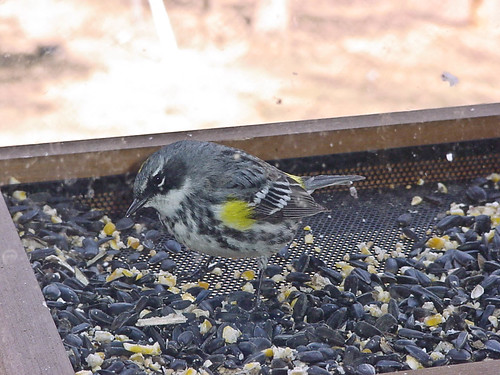 |
| My feeder April 2001 |
I went more than a decade without seeing another at the feeders, though they have always been common migrants in my trees. But they do seem to pay attention to chickadees and other feeder birds, and in Spring 2013, one showed up at one of my feeders again.
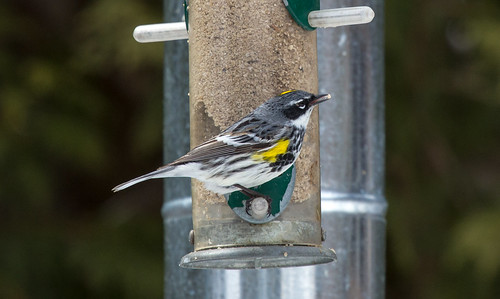 |
| My yard, April 2013 |
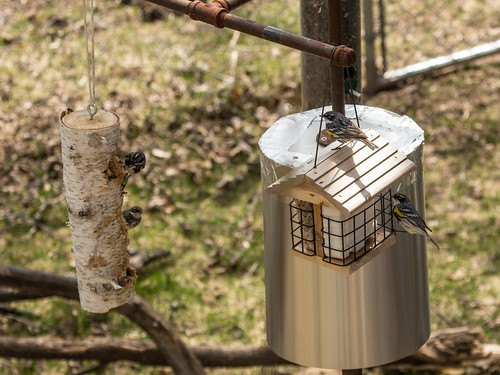 |
| My yard May 2014 |
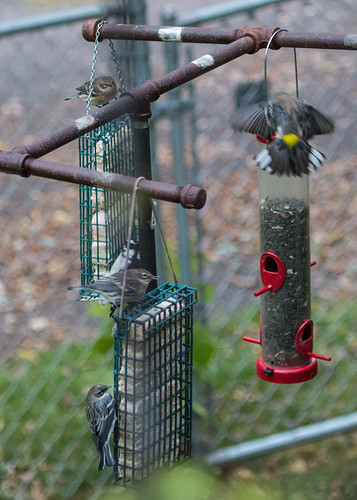 |
| October 2014 |
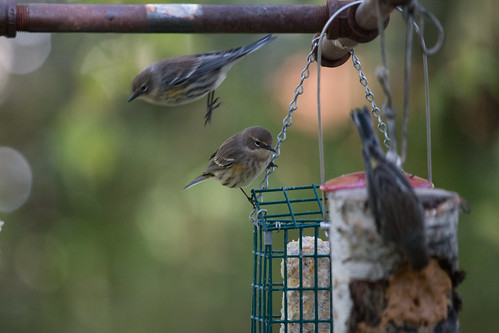 |
| October 2014 |
I thought I was seeing a sea change in Yellow-rumped Warbler behavior, but didn't have them at my feeders at all in 2015, though in the spring I did have Cape May Warblers visiting them for a few days--the last time that happened was in 2004. They put on quite a show this year, when I had the camera equipment to take advantage.

We can't help but be curious about whether climate change was involved in Maxene's bird remaining so very late, but Yellow-rumped Warblers have been considered rare winter visitors in Minnesota for many decades. Even so, Maxene's bird was obviously quite exceptional.
She said the warbler was most active in the low light of dawn and dusk and was skittish, making photography difficult at best, but she did get distant photos on January 22.
 |
| Maxene's warbler wasn't as cooperative as mine--under harsh winter conditions, who could blame it? |
Sadly, that ended up being the
last day she saw the little thing. It had survived that week of nights
with double-digits below zero, and the 22nd happened to be right
when the temperatures were rising again, so there’s a good chance
that after getting through the worst of it, it decided to take advantage of the
milder conditions to head south.
But we’ll never know for sure. The
little Indigo Bunting in my own neighborhood disappeared weeks ago, but like
the warbler, there was no particular indication that the bird was in distress,
so nowhere near the certainty that it had succumbed like our Duluth Ivory Gull did.
Fruit-eating birds such as robins and waxwings, and yellow-rumps, which specialize
on wax myrtle berries, tend to be more flexible in their winter movement
patterns than most birds, so it’s quite likely that this little mite wandered
south, and may right now be basking with other yellow-rumps in Texas or
Florida. Without evidence either way, that’s the picture I’m keeping in my mind’s
eye. After all, hope is the thing with feathers that perches in the soul.
